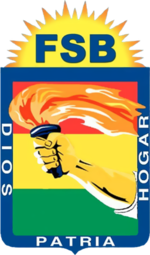
Hugo Banzer Suárez was a Bolivian politician and military officer who served as the 51st president of Bolivia. He held the Bolivian presidency twice: from 1971 to 1978 in a military dictatorship; and then again from 1997 to 2001, as a democratically elected president.

The Revolutionary Nationalist Movement is a centre-right, conservative political party in Bolivia. It was the leading force behind the Bolivian National Revolution from 1952 to 1964. It influenced much of the country's history since 1941.

Óscar Únzaga de la Vega was a Bolivian political figure and rebel. Most significantly, he founded the Bolivian Socialist Falange (FSB) movement in 1937, and ran for President in the 1956 elections, when his party became the main opposition movement to the Movimiento Nacionalista Revolucionario (MNR).

Ángel Víctor Paz Estenssoro was a Bolivian politician who served as the 45th president of Bolivia for three nonconsecutive and four total terms from 1952 to 1956, 1960 to 1964 and 1985 to 1989. He ran for president eight times and was victorious in 1951, 1960, 1964 and 1985. His 1951 victory was annulled by a military junta led by Hugo Ballivián, and his 1964 victory was interrupted by the 1964 Bolivian coup d'état.

Hernán Siles Zuazo was a Bolivian politician who served as the 46th president of Bolivia twice nonconsecutively from 1956 to 1960 and from 1982 to 1985. He also briefly served as interim president in April 1952, and as the 27th vice president of Bolivia from 1952 to 1956.

Jaime Paz Zamora is a former Bolivian politician who served as the 60th president of Bolivia from 1989 to 1993. He also served as the 32nd vice president of Bolivia from October 1982 to December 1984 during the presidency of Hernán Siles Zuazo.
The Revolutionary Left Movement – New Majority was a social democratic political party in Bolivia whose registration was annulled in 2006 after it failed achieve the electoral results needed to maintain its official registration. In the elections of 2009, the party did not field any candidates. It was a member of the Socialist International.

Juan Lechín Oquendo was a labor-union leader and head of the Federation of Bolivian Mine Workers (FSTMB) from 1944 to 1987 and the Bolivian Workers' Union (COB) from 1952 to 1987. He also served as the 29th vice president of Bolivia between 1960 and 1964.
Falangism in Latin America has been a feature of political life since the 1930s as movements looked to the national syndicalist clerical fascism of the Spanish state and sought to apply it to other Spanish-speaking countries. From the mid-1930s, the Falange Exterior, effectively an overseas version of the Spanish Falange, was active throughout Latin America in order to drum up support among Hispanic communities. However, the ideas would soon permeate into indigenous political groups. The term "Falangism" should not be applied to the military dictatorships of such figures as Alfredo Stroessner, Augusto Pinochet and Rafael Trujillo because while these individuals often enjoyed close relations to Francisco Franco's Spain, their military nature and frequent lack of commitment to national syndicalism and the corporate state mean that they should not be classed as Falangist. The phenomenon can be seen in a number of movements both past and present.
Bolivia's defeat by Paraguay in the Chaco War of 1932–1936 marked a turning point in the modern history of Bolivia. Great loss of life and territory discredited the traditional ruling classes, while service in the army produced stirrings of political awareness among the indigenous people. A large portion of the contested Gran Chaco region was surrendered to Paraguay. In return Bolivia was given access to the Paraguay River where Puerto Busch was founded and, with this, free access to the Atlantic Ocean through international waters was possible. In 1936 Standard Oil's Bolivian operations were nationalized and the state-owned firm Yacimientos Petroliferos Fiscales Bolivianos (YPFB) was created. From the end of the Chaco War until the 1952 Bolivian National Revolution, the emergence of contending ideologies and the demands of new groups convulsed Bolivian politics.

The history of Bolivia from 1964 to 1982 is a time of periodic instability under various military dictators. On November 4, 1964, power passed from the elected leader of the Bolivian National Revolution, Víctor Paz Estenssoro to a military junta under popular vice-president General René Barrientos. Barrientos was elected president in 1966, but died suspiciously in a helicopter crash in 1969 while touring the countryside visiting the indigenous people of Bolivia, this led to a coup in September 1969 by General Ovando, who was overthrown in October 1970 by General Rogelio Miranda who was overthrown a couple of days later by General J.J.Torres, who in turn was overthrown in August 1971 by Hugo Banzer Suárez. Banzer ruled for seven years, initially from 1971 to 1974 with the support of Estenssoro's Nationalist Revolutionary Movement. In 1974, impatient with schisms in the party, he replaced civilians with members of the armed forces and suspended political activities. The economy grew impressively during Banzer's presidency, but demands for greater political freedom undercut his support. He called elections in 1978 and Bolivia once again plunged into turmoil. Juan Pereda ruled for only four months in 1978, but his ascent to the presidency marked the beginning of an even more unstable period in Bolivian history, with nine civilian and military presidents in little over four years (1978–1982). 1982 marked the return to a democratically elected government, with Guido Vildoso as president.

General elections were held in Bolivia on 1 July 1979. As no candidate in the presidential elections received a majority of the vote, the National Congress was required to elect a President. However, the Congress failed to elect a candidate after three ballots and instead selected Senate leader Wálter Guevara to serve as Interim President for a year on 8 August. Guevara was later overthrown by a military coup led by Alberto Natusch on 31 October. Fresh elections were held in June 1980.

General elections were held in Bolivia on 29 June 1980, the third in three years. As no candidate in the presidential elections received a majority of the vote, the National Congress was required to elect a President on 6 August. With Hernán Siles Zuazo of the Democratic and Popular Union the favourite to win the Congressional ballot, the process was disrupted on 17 July by the military coup led by General Luis García Meza Tejada. However, Meza was pressured to resign on 4 August 1981, resulting in General Celso Torrelio becoming president. In July 1982 he was replaced by General Guido Vildoso, who was named by the high command to return the country to democratic rule. On 17 September 1982, during a general strike that brought the country close to civil war, the military decided to step down, to reconvene the National Congress elected in 1980, and to accept its choice of president. Accordingly, the National Congress revalidated the 1980 election results on 23 September and overwhelmingly elected Hernán Siles Zuazo as president on 5 October. He subsequently assumed the presidency on 10 October 1982.

General elections were held in Bolivia on 14 July 1985. As no candidate for the presidency received over 50% of the vote, the National Congress was required to elect a President on 4 August. Although Hugo Banzer of Nationalist Democratic Action (ADN) received the most public votes, Congress elected Víctor Paz Estenssoro of the Revolutionary Nationalist Movement (MNR).
The Left-wing Revolutionary Nationalist Movement was a centre-left political party in Bolivia.
The Revolutionary Nationalist Movement–Julio was a pro-military political party in Bolivia.
The Bolivian National Congress 1979–1980 was elected on 1 July 1979.

The Bolivian Revolution of 1952, also known as the Revolution of '52, was a series of political demonstrations led by the Revolutionary Nationalist Movement, which, in alliance with liberals and communists, sought to overthrow the ruling Bolivian oligarchy and implement a new socioeconomic model in Bolivia. Its main leaders were the former presidents Víctor Paz Estenssoro and Hernán Siles Zuazo. The MNR government after this Revolution lasted from 9 April 1952 until the coup of 4 November 1964. In these twelve years, there was a co-government and at the same time a power struggle between the party and the labor unions.
Bolivia has experienced more than 190 coups d'état and revolutions since its independence in 1825. Since 1950, Bolivia has seen the most coups of any other country. The last known attempt was in 1984, four years after the country's transition to democracy in 1980.
Events in the year 1959 in Bolivia.














